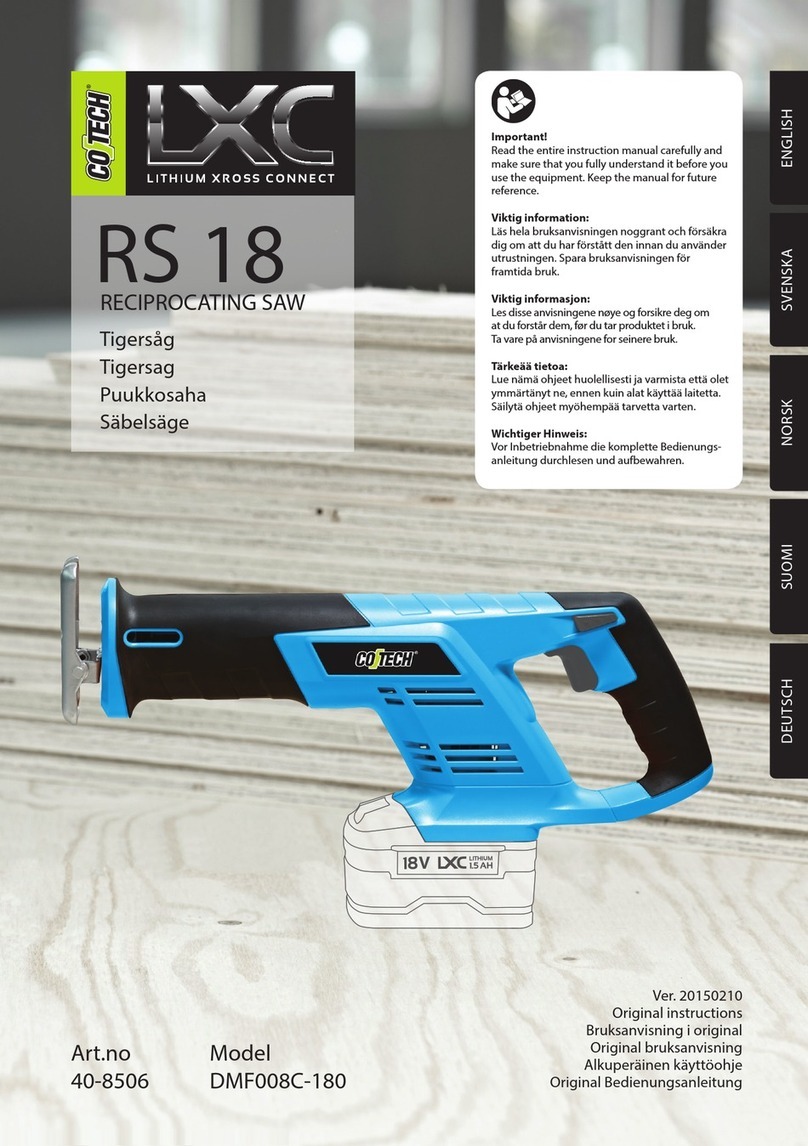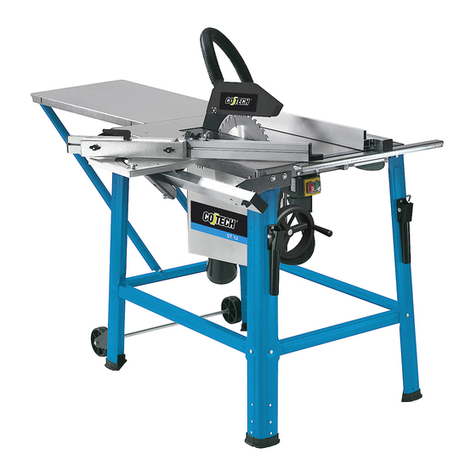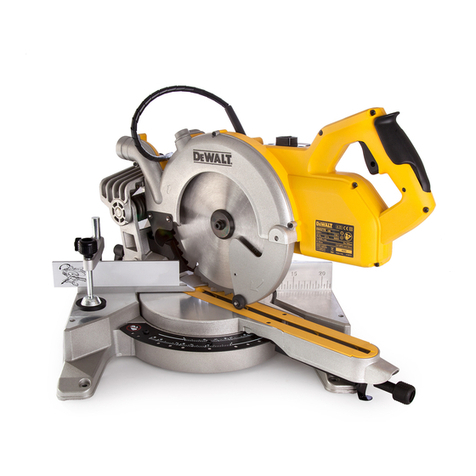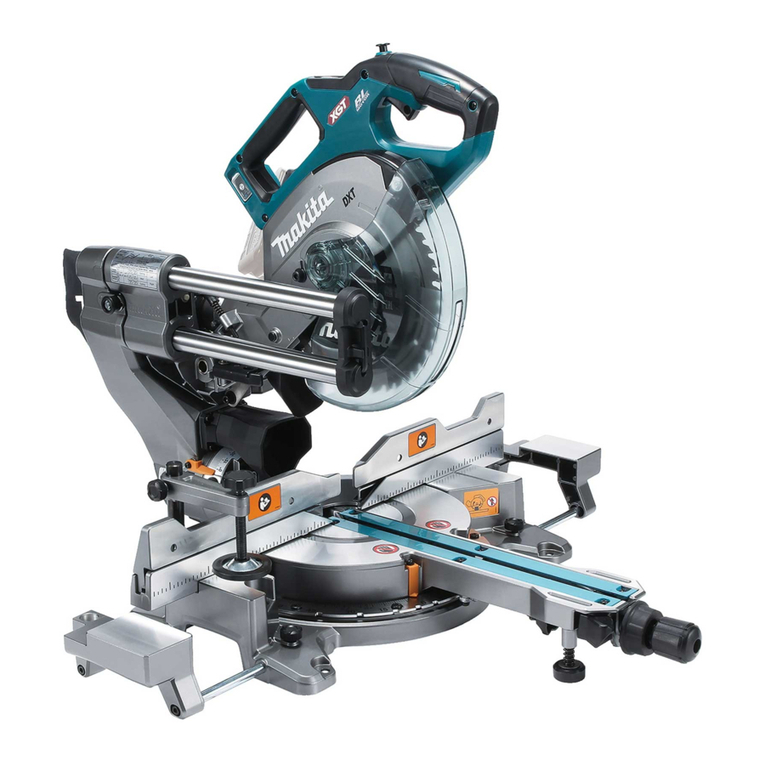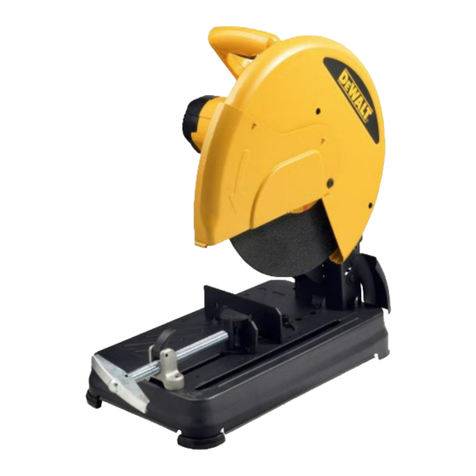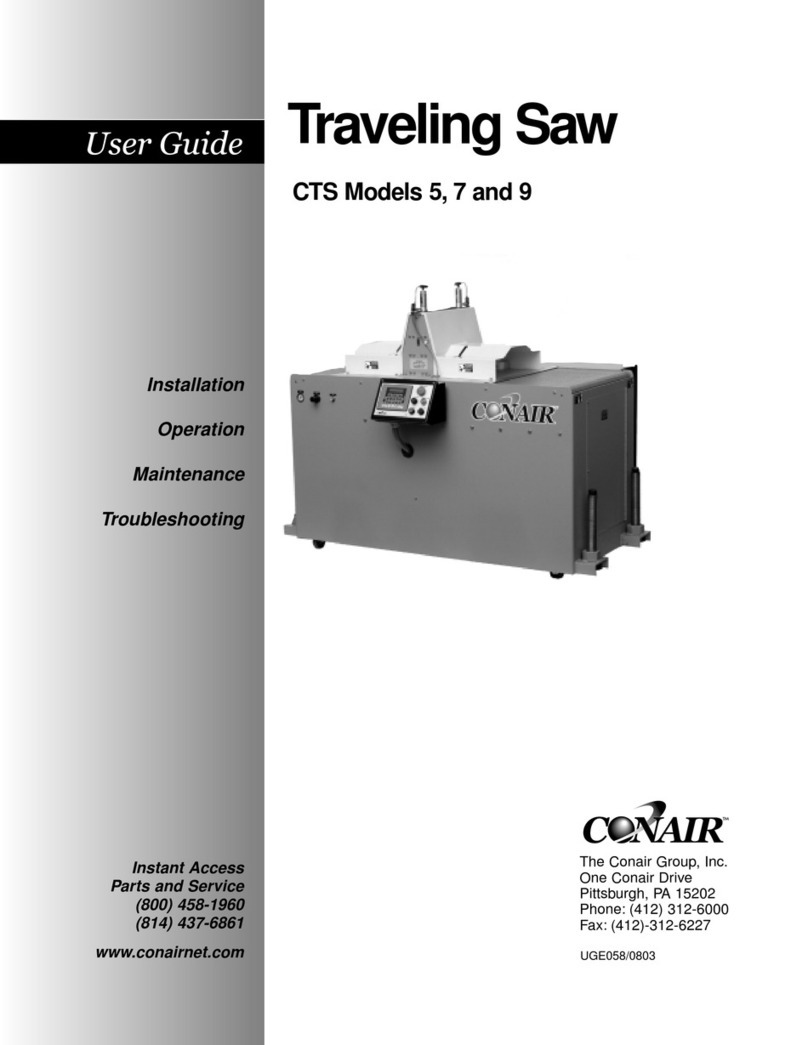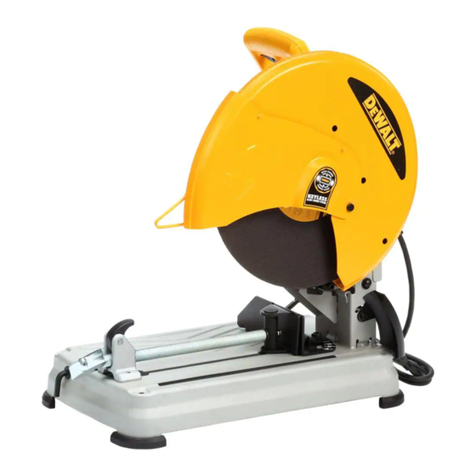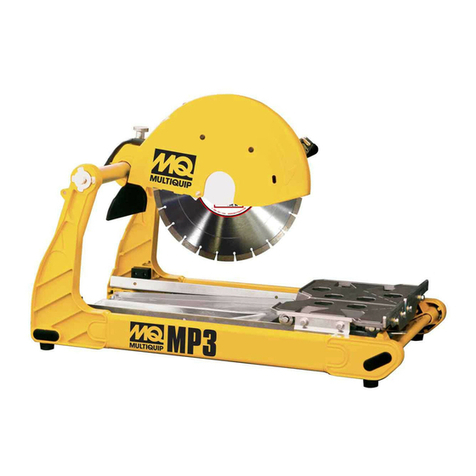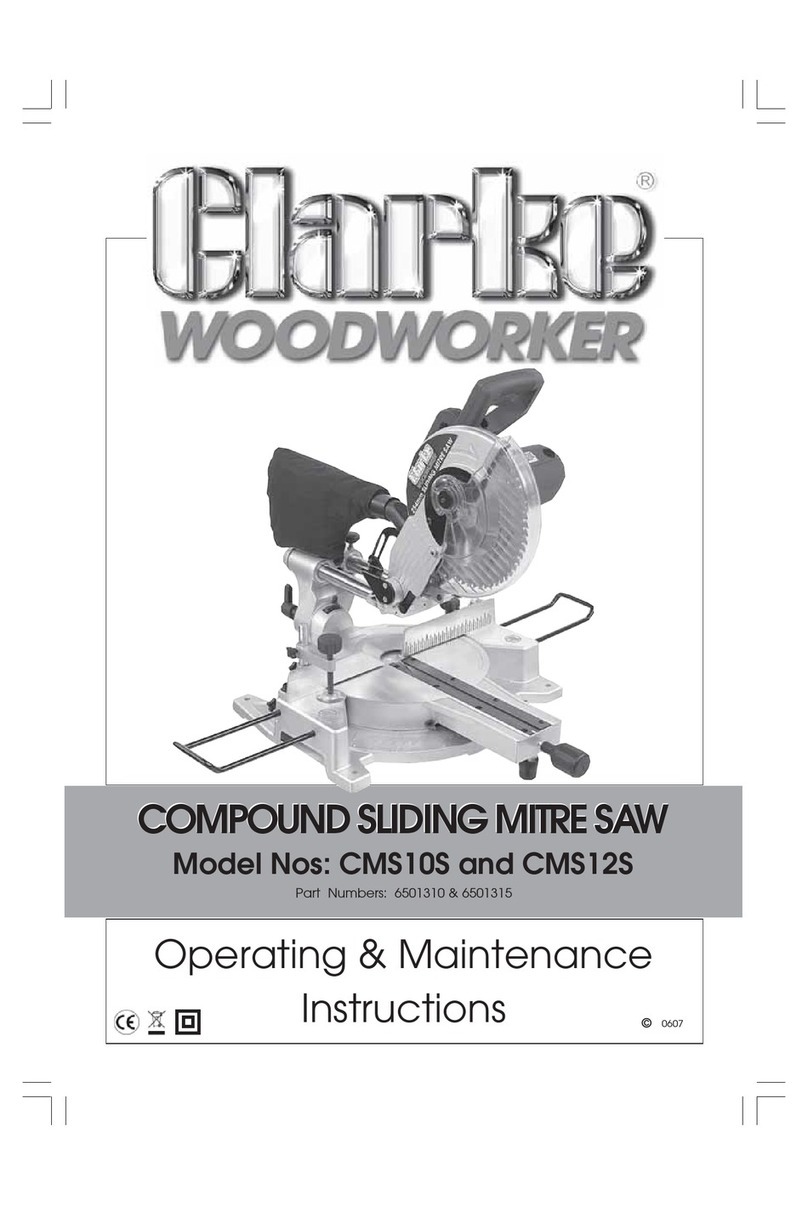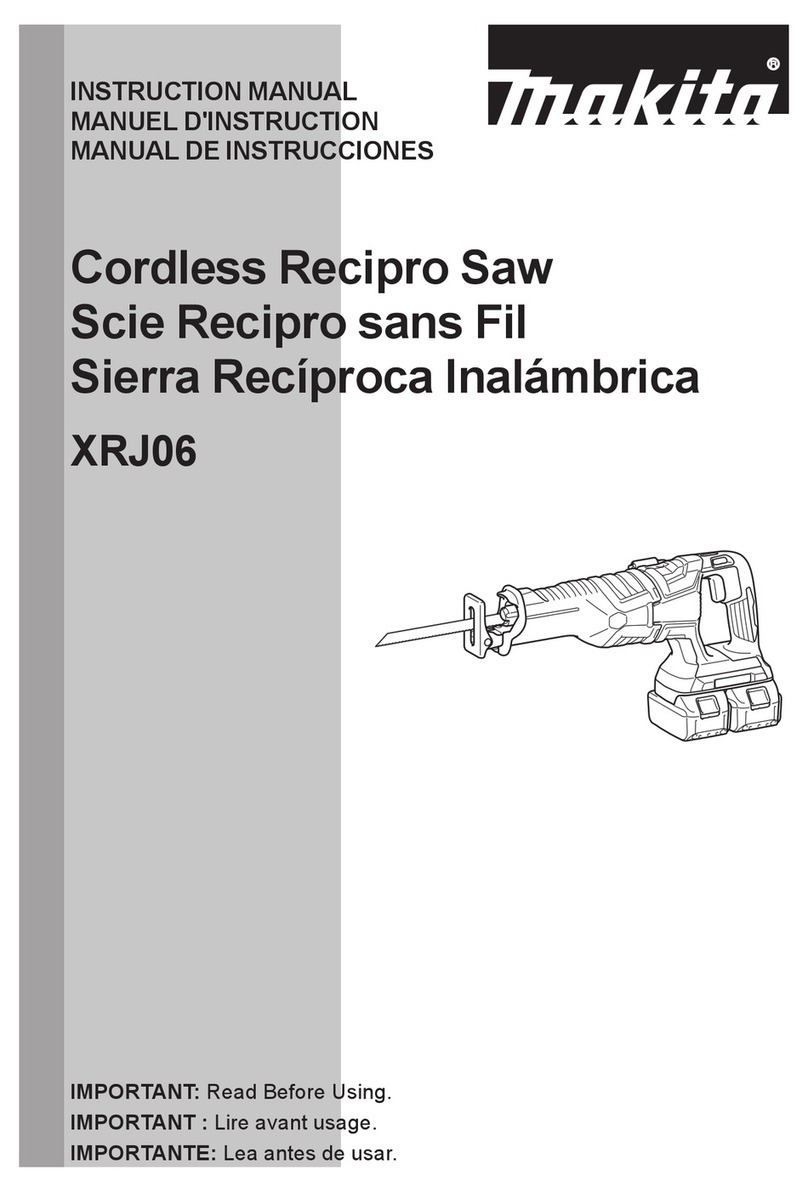CO/Tech 92107L-UK User manual

ENGLISH
SVENSKANORSKSUOMI
DEUTSCH
Important!
Read the entire instruction manual carefully
and make sure that you fully understand
it before you use the equipment. Keep the
manual for future reference.
Viktig information:
Läs hela bruksanvisningen noggrant och
försäkra dig om att du har förstått den innan
du använder utrustningen. Spara manualen
för framtida bruk.
Viktig informasjon:
Les disse anvisningene nøye og forsikre deg
om at du forstår dem før du tar produktet i bruk.
Ta vare på anvisningene for seinere bruk.
Tärkeää tietoa:
Lue nämä ohjeet huolellisesti ja varmista
että olet ymmärtänyt ne, ennen kuin alat
käyttää laitetta. Säilytä ohjeet myöhempää
tarvetta varten.
Wichtiger Hinweis:
Vor Inbetriebnahme die komplette
Bedienungsanleitung durchlesen und
aufbewahren.
Ver. 20131211
Original instructions
Bruksanvisning i original
Original bruksanvisning
Alkuperäinen käyttöohje
Original Bedienungsanleitung
Art.no. Model
18-3173 92107L-UK
40-7956 92107L
Sliding Compound
Mitre Saw
Kap- och Geringssåg (skjutbar)
Kapp- og Gjæresag (skyvbar)
Katkaisu- ja jiirisaha (liu’ulla)
Kapp- und Gehrungssäge (mit Gleitfunktion)

2

3
ENGLISH
Sliding Compound Mitre Saw
Art.no. 18-3173 Model 92107L-UK
40-7956 92107L
Please read the entire instruction manual before use and save it for future reference. We reserve the right for any
errors in text or images and for making any necessary technical changes to this document. If you should have
any questions concerning technical problems please contact our Customer Services.
• Read the entire instruction manual before using the product and keep it for future reference.
• Always pull the plug out of the wall socket before servicing and adjusting the product.
Things to consider
• Working with wood can be dangerous if the correct procedures are not observed.
• Using the saw with common sense and caution will greatly reduce the risk of personal injury.
• Safety devices such as guards, push-sticks, clamps, safety goggles, dust masks and ear defenders
can never make up for bad judgement, carelessness or inattentiveness.
• N.B: you are responsible for your own safety. The saw has been designed to perform certain tasks.
We strongly recommend that the saw is not altered in any way and that it is not used for performing
any task for which it was not designed.
• DO NOT USE THE SAW if you are unsure if the saw can perform the task you intend to perform.
Safety
Warning!
When using this tool all basic safety precautions must be followed to avoid the risk of fire, electrocution and
personal injury. Read these instructions carefully before using the product and keep them for future reference.
Keep the working area tidy.
• Cluttered surfaces and benches invite accidents.
Take stock of your working environment.
• Do not expose the tool to rain.
• Do not use the tool in moist or wet areas.
• Keep the working area well lit.
• Never operate the tool near flammable liquid or gas.
Avoid electric shocks.
• Avoid body contact with earthed objects, such as pipes, radiators, ovens or refrigerators.
Keep other people at a safe distance.
• Do not allow anyone not involved in the work process to touch the tool or its electric cable,
especially children. Keep all bystanders at a distance.
Store the tool in a safe place.
• When your tools are not in use, keep them in a locked, dry area, away from children.
Do not overload the tool.
• The correct feed rate makes the work better and safer.
Use the correct tool for the job.
• Do not try to use small tools to perform jobs requiring more powerful tools.
• Do not use a tool for a purpose for which it was not designed, e.g. using a circular saw for lopping
branches off trees.

4
ENGLISH
Wear suitable clothing.
• Do not wear loose-fitting clothing or jewellery; they could be caught in moving parts.
• Non-slip shoes are recommended for outdoor work.
• Wear a hairnet or similar if you have long hair.
Always use safetywear.
• Wear safety glasses.
• Use a dust mask or dust filter when working in dusty environments.
Use dust extractors.
• If the tool is equipped with or connected to a dust extractor/collector, make sure that it is turned on
and used correctly.
Do not abuse the lead.
• Do not jerk the lead, grip the plug itself when disconnecting the power. Make sure that the mains lead
does not come into contact with heat, oil, or sharp edges.
Firmly secure the workpiece.
• If possible use vices or clamps to hold the workpiece in place. This is much safer than holding
the workpiece in one hand.
Do not overreach.
• Make sure that you stand steady and balanced all times.
Look after you tools.
• Make sure that they are clean and that the edges are sharp for maximum effect and best results.
• Follow the manuals recommendations regarding lubrication and replacement of accessories.
• Inspect the mains lead regularly. If it is damaged it should be replaced by a qualified service technician.
• Inspect all leads and cables regularly to check for any damage.
• Make sure that the machine’s handles and controls are clean, dry and free from oil and grease.
Turn the power off.
• Pull out the plug and push in the emergency stop button before servicing or changing any blades, drill bits,
cutters or sanding discs.
Remove all spanners and repair tools.
• Make a habit of checking to make sure that the machine is free of all spanners and tools
before turning the power on.
Avoid accidental starts.
• Do not walk around with your finger on the trigger of a power tool if it is plugged in. Make sure
that the on/off switch is set to OFF before plugging in any power tool.
Use the correct extension leads.
• If you use extension leads outdoors, only use those designed for outdoor use. Only use extension leads
with thick enough diameter core wires and roll out the whole lead.
Use common sense and be careful.
• Think before carrying out any task, so that it is carried out safely. Never operate machines/power tools
when you are tired or under the influence of medicine.
Check the following before turning the tool on:
• That all guards and other parts are whole and in working order.
• That moving parts are free and correctly aligned.
• That no moving parts can get caught.
• That there are no visible defects.
• Other factors that can influence work execution.
Use only recommended accessories.
• The use of non-recommended accessories can cause accidents and personal injury.
Should only be repaired by a qualified technician.
• This tool conforms to current safety requirements.
• Repairs to the tool should only be carried out by a tradesman using original spares; otherwise the tool could
cause accidents and personal injury.

5
ENGLISH
!
!
!
!
!
!
!
!
Additional safety rules for compound mitre saws
• Never use cracked or damaged saw blades.
• Replace the kerf plate when it is worn.
• Use only saw blades recommended by the manufacturer.
• Never use blades made of high speed steel (HSS).
• Select the correct blade for the material to be cut.
• Never saw material other than that for which the saw blade is intended.
• Observe the maximum speed marked on the saw blade.
• When moving the mitre saw, hold it by the handle.
• Do not operate the machine without the guard in position, or if the guard does not function
or is not maintained properly.
• Keep the surrounding work area free of loose chips and offcuts.
• Use only those spacers and spindle adaptors approved for your saw.
• If the laser is fitted with a laser, it must not be replaced by a different type. If damaged, have
the laser repaired by the manufacturer or an authorised repair agent.
• Do not remove any offcuts or jammed material from around the blade area until the blade has stopped.
• Before sawing, make sure that the saw is stable and secure. When possible, always mount
the machine to a bench.
• When sawing, always secure the workpiece using clamps or a vice if possible.
• Use a table, roller stand, or similar to support long workpieces.
In spite of the application of the relevant safety rules and the implementation of safety
devices, certain residual risks cannot be avoided. The following hazards are inherent to the
use of mitre saws:
• Contact with uncovered parts of the rotating saw blade.
• Contact with rotating saw blade (cuts).
• Workpiece or parts of it can be ejected back towards the user (kickback).
• Shattered saw blade.
• Flying metal particles if the carbide tips break off.
• Impairment of hearing if ear defenders are not worn.
• Health hazards caused by breathing dust in poorly ventilated work areas.
Safety symbol guide
Read the entire operations manual.
Read the entire operations manual and
attempt to understand how
the machine works.
Use ear plug!
There is a risk of impaired hearing.
Always use ear plugs when operating
the machine.
Use protective eyeglasses!
Protect your eyes from flying
debris and use protective
eyeglasses or a visor.
Use protective shoes!
Use protective shoes with a steel toe
that protect against falling objects.
Keep visitors away from
the proximity of the machine!
Keep children, pets, and spectators
a minimum of 5 metres away from
the risk zone of the machine.
Caution: Be attentive, keep your hands
away from the proximity of the saw blade!
There is a risk of injury during contact with
rotating saw blade, also at a low speed.
Do not use the help of assistants,
unless necessary!
It is prohibited for people other than the
machine operator to be present in the risk
zone of the machine.
Turn off the machine and unplug it from the
power source before cleaning and service!

6
ENGLISH
Description
1. Release lever
2. Handle
3. On/off switch
4. Saw head
5. Saw blade
6. Moveable blade guard
7. Fence
8. Turntable
9. Base
10. Locking knob
11. Fixed setting lock
12. Index mark
13. Graduations
14. Locking knob
15. Rail locking knob
16. Bevel scale
17. Locking pin
18. Spindle lock
19. Carbon brush cover
20. Clamp
21. Stand
22. Bolt
23. Rotation direction arrow
(under the blade guard
in picture)
24. Dust bag
25. Adjustment screw 0°
26. Adjustment screw 45°
27. Laser
28. Battery compartment
with laser
on/off switch
17
16
15
5
1078
6
19
23
11
28
27
20
1
2
18
4
3
21 14
24
1213
22
9

7
ENGLISH
Technical data
Motor 230 V AC, 50 Hz
Rated power 1800 W
No-load speed 4800 rpm
Saw blade, tungsten carbide tipped Ø 210 × Ø 30 × 2.6 mm
Number of teeth 24 T
Saw blade bevel tilt 0° - 45° to the left
Mitre angles 45° / 0° / 60°
Table 500 × 160 mm
Max workpiece size at 90° 305 × 65 mm
Max workpiece size at 45° 210 × 65 mm
Max workpiece at 2 × 45°
(double mitre cut) 210 × 43 mm
Laser Class 2 according to EN 60825-1
P = < 1 mW, λ= 650 nm
Package contents
• Clamp
• Spanner
• Dust bag
• Support (2 ×)
• Instruction manual
Before operating the machine
• The machine must be firmly mounted to a bench or stand.
• All covers and safety devices have to be properly fitted before the machine is switched on.
• The saw blade must be able to turn freely in all positions.
• When working with wood that has been used before, watch out for foreign bodies such as screws or nails.
• Before switching the machine on, make sure that the saw blade is correctly fitted and that all moving parts
run smoothly.
• Before connecting the machine to the power supply, make sure that the data on the rating plate is the same
as that of your mains power.

8
ENGLISH
Cross Cutting
Making 90° crosscuts with the turntable at 0°
When cutting workpieces up to 100 mm in width the slide function is not needed and the saw can be locked in
the rear position using the rail locking knob (15). For cutting workpieces wider than 100 mm, you must ensure
that the locking knob (15) is slackened and that the saw head (4) can be moved.
1. Raise the saw head (4) to its upper position by releasing the lock (17).
2. Push the saw head (4) back by its handle (2) and fix it in this position if necessary (depending on
the cutting width).
3. Place the workpiece against the fence (7) on the turntable (8).
4. Secure the workpiece to the base using the clamp (20) to prevent it from moving during the cutting process.
5. Press in the on/off switch to start the motor, turn the release lever and carefully lower the handle (2).
Let the saw cut through the workpiece.
6. When the cutting process is finished: Release the on/off switch (3). When the motor has stopped, the saw
head (4) can be brought back to its upper position.
17
Warning! The resetting springs in the machine automatically raise the saw head after cutting. Do not simply
let go of the saw head (2) after cutting, hold onto the handle and let it come up slowly.

9
ENGLISH
Making crosscuts with blade tilted at 0°-45°
This mitre saw is capable of cutting at a tilt angle of 0–45°.
1. Undo the lock (14) and tilt the blade to the desired angle with the help of the bevel scale (16).
2. Tighten the locking knob (14) to lock the bevel angle.
3. Cut as described above.
Precision adjustment of 0° and 45° angles
1. Undo the locking knob (14) and angle
the saw to 0°.
2. Check the angle between the blade and the
turntable using a 90° angle guide.
3. Adjust the end stop using the adjustment
screw (25) by slackening the nut and turning
the screw. Lock the screw again afterwards
by re-tightening the nut.
4. To adjust the 45° end stop, do as above but
use the adjustment screw (26) and a 45°
angle guide.
1016
1014
1026
1025

10
ENGLISH
Mitre Cutting –45/ 0° / +60°
This saw is capable of making mitre cuts at angles of - 45° / 0° / + 60°.
1. Raise the saw head (4) to its upper position by releasing the lock (17).
2. Undo the locking knob (10) and set the saw to the desired mitre angle using the scale (13).
3. Tighten the locking knob (10) and cut as previously described.
Sawing bowed workpieces
When sawing flat workpieces, check if the workpiece is bowed. Turn it as shown in the figure to prevent it
from pinching the blade after cutting.
Correct Incorrect
Dust bag
The saw is fitted with a dust bag (24) which can be emptied by opening the zip on the bottom.
A dust extractor can also be attached to the outlet.
1010
1024
1013

11
ENGLISH
Changing the blade
1. Unplug the machine.
2. Pull out the locking pin (17) and carefully lift the saw head.
3. Press in the spindle lock (18) with one hand and turn the blade with your other hand until it locks.
Keep the spindle lock pressed in and undo the blade flange bolt with the spanner (turn clockwise).
4. Remove the flange bolt and the outer flange.
5. Take the blade off the inner flange and pull it out.
6. Mount the new blade in the reverse order.
7. Clean the saw blade flanges and bolt thoroughly before mounting the new blade.
The direction of rotation of the blade must be the same as the arrow on the housing.
8. Make sure the spindle lock is off.
9. Before using the saw again, make sure that all safety devices are in good working order.
Note! The spindle has a 16 mm diameter and an insert ring is fitted with the original blade that
has a 30 mm diameter. The saw can be used with blades with either a 16 mm or 30 mm bore.
Warning! Every time you change the blade, make sure that it spins freely in all angle settings.
Warning! Remove the spanner and release the spindle lock before switching the machine on.
Laser
This saw is equipped with a laser that projects
a laser cutting line onto the workpiece. The laser’s
on/off switch is located on the battery compartment.
Laser`s
on/off switch

12
ENGLISH
Min. length 6 mm
Inspecting and replacing carbon brushes
Warning! Unplug the machine before inspecting the carbon brushes.
The life expectancy of the brushes depends on how hard the motor has been run. The brushes should be
checked after 50 hours operation if the saw is new or if they have been replaced. They should then be checked
after every 10 hours operation.
Check the carbon brushes as follows:
1. Remove the covers (19) on each side of the motor.
2. Extract the carbon brushes.
3. Check their length (min 6 mm).
4. If either of the brushes is shorter than 6 mm or the spring is damaged, they must both be changed.
Troubleshooting guide - motor
• To prevent the motor from overheating it should be regularly air-blasted to remove any dust
or wood chips from clogging the air vents.
• Use the saw with an earthed power supply protected by a 10 A slow blow fuse.
• Release the on/off switch immediately if the motor does not start straight away. Pull out
the plug and make sure that the blade spins freely.
• If the motor stops in the middle of sawing: Release the on/off switch and pull out the plug.
Remove the blade from the workpiece, plug the saw in again and try starting the motor again.
• Check for loose connections, overloading (several devices on the same fuse circuit), cable core area
(1.5 mm² up to 7 m in length, or at least 2 mm² for 7–15 m cable) and length of cable (not over 15 m).
Ordering replacement parts
Specify the following data when ordering spare parts:
• Type of machine
• The machine’s model
• The article number of the machine

13
SVENSKA
Kap- och geringssåg (skjutbar)
Art.nr. 18-3173 Modell 92107L-UK
40-7956 92107L
Läs igenom hela bruksanvisningen före användning och spara den sedan för framtida bruk. Vi reserverar oss
för ev. text- och bildfel samt ändringar av tekniska data. Vid tekniska problem eller andra frågor, kontakta vår
kundtjänst (se adressuppgifter på baksidan).
• Läs hela bruksanvisningen innan du använder produkten och spara den för framtida bruk.
• Dra alltid ut nätsladdens stickpropp ur uttaget innan service och justering av produkten!
Tänk på detta
• Att arbeta i trä kan vara farligt om man inte gör på rätt sätt!
• Om du använder sågen med sunt förnuft och försiktighet minskar du avsevärt riskerna för personskada.
• Säkerhetsutrustning i form av skydd, påskjutare, tvingar, skyddsglasögon, dammfilter och hörselskydd kan
inte kompensera dåligt omdöme, vårdslöshet eller ouppmärksamhet!
• Kom ihåg: du ansvarar själv för din egen säkerhet. Sågen har konstruerats för vissa arbetsuppgifter.
Vi rekommenderar starkt att du inte ändrar sågen eller använder den till något annat än det som den
har konstruerats för.
• ANVÄND INTE SÅGEN om du är osäker på om den kan eller bör användas på så sätt som du har tänkt göra!
Säkerhet
Varning!
När du använder detta verktyg ska grundläggande försiktighetsåtgärder iakttas för att minska risken för brand,
elektrisk chock och personskada. Läs alla dessa instruktioner innan du använder produkten och spara dessa
instruktioner.
Håll arbetsplatsen ren.
• Belamrade ytor och bord inbjuder till olyckor.
Tag hänsyn till arbetsmiljön.
• Utsätt inte verktygen för regn.
• Använd inte verktygen i fuktiga eller våta utrymmen.
• Håll arbetsplatsen väl upplyst.
• Använd inte verktygen i närheten av lättantändliga vätskor eller gaser.
Undvik elektrisk chock.
• Undvik kroppskontakt med jordade föremål som t.ex. vattenledningar, element, köksspisar och kylskåp.
Håll andra människor på avstånd.
• Låt inga människor, speciellt inte barn, som inte deltar i arbetet röra vid verktyget eller dess skarvsladdar.
Håll dem på avstånd från arbetsplatsen.
Förvara verktyget i ett säkert utrymme.
• När verktygen inte används, förvara dem i ett torrt låst utrymme utom räckhåll för barn.
Överbelasta inte verktyget.
• Det gör jobbet bättre och säkrare med avsedd matningshastighet.
Använd rätt verktyg.
• Pressa inte små verktyg att utföra stora jobb som kräver kraftfulla verktyg.
• Pressa inte ett verktyg eller en tillsats att göra ett arbetsmoment som den inte är gjord för; använd t.ex.
inte en cirkelsåg för att kapa trädgrenar eller timmer.

14
SVENSKA
Bär lämplig klädsel.
• Bär inga löst sittande kläder eller smycken, de kan fastna i roterande delar.
• Halksäkra skor rekommenderas vid arbete utomhus.
• Bär hårnät eller liknande om du har långt hår.
Bär alltid skyddsutrustning.
• Bär skyddsglasögon.
• Använd också dammfilter eller skyddsmask vid dammande arbeten.
Använd utsugningsutrustning.
• Om verktyget är förberett för anslutning av utrustning för utsugning och uppsamling av damm, se
till att utrustningen är ansluten och korrekt använd.
Misshandla inte nätsladden.
• Ryck inte i sladden, utan dra i stickproppen när du ska ta ur den ur vägguttaget. Se till att nätsladden
inte kommer i kontakt med värme, olja eller vassa kanter.
Spänn fast arbetsstycket ordentligt.
• När det är möjligt, använd tvingar eller skruvstäd för att spänna fast arbetsstycket. Det är säkrare
än att hålla fast arbetsstycket med ena handen.
Sträck dig inte för långt.
• Se till att du hela tiden står säkert med god balans.
Håll verktygen i trim.
• Se till att de är rena och eggarna vassa för optimal effekt och ett säkert resultat.
• Följ manualens rekommendationer för smörjning och byte av tillbehör.
• Kontrollera nätsladden regelbundet. Om den är skadad ska den bytas av en kvalificerad servicetekniker.
• Syna alla skarvsladdar regelbundet så att de inte är skadade.
• Se till att maskinens/verktygets handtag och reglage är torra, rena och helt fria från olja, fett etc.
Slå av strömmen.
• Dra ur stickproppen och tryck in nödstopp före service och vid byte av tillbehör som hyvelstål,
borrar, stål, slipband eller blad.
Ta bort alla nycklar och serviceverktyg.
• Gör det till en vana att kontrollera att alla nycklar och serviceverktyg är borttagna från maskinen
innan du slår på strömmen.
Undvik oavsiktlig start.
• Bär inte ett verktyg med ett finger på strömbrytaren/avtryckaren om sladden sitter i ett uttag.
• Se till att strömbrytaren står på OFF när du sätter in stickproppen.
Använd rätt skarvsladdar.
• Om du använder skarvsladdar utomhus, använd endast de som är avsedda för utomhusbruk.
• Använd skarvsladdar med tillräcklig ledararea och rulla ut hela sladden.
Använd sunt förnuft och var försiktig.
• Tänk efter innan du utför ett arbetsmoment, så att du kan utföra det på ett säkert sätt.
• Använd inte maskinen/verktyget när du är trött, påverkad av mediciner etc.
Kontrollera följande innan du startar verktyget:
• Att alla skydd och övriga delar är oskadade och fyller sin funktion.
• Att rörliga delar kan rotera fritt och är rätt inriktade.
• Att inga rörliga delar kan fastna.
• Att ingen defekt har uppstått.
• Andra omständigheter som kan påverka arbetets utförande.
Använd rekommenderade tillbehör.
• Användning av ej rekommenderade tillbehör kan vålla olyckor eller risk för personskada.
Repareras endast av kvalificerad tekniker.
• Verktyget överensstämmer med gällande säkerhetskrav. Reparationer av verktyget ska alltid utföras av
fackman, med originalreservdelar, annars kan verktyget vålla olyckor eller risk för personskada.

15
SVENSKA
!
!
!
!
!
!
!
!
Särskilda säkerhetsföreskrifter kap- och geringssågar
• Använd aldrig sågklingor som är skadade eller deformerade.
• Byt ut bordsinlägget om det är slitet.
• Använd endast sågklingor som är rekommenderade av tillverkaren.
• Använd aldrig sågklingor som är tillverkade av snabbstål.
• Välj sågklinga som är lämplig för det material du ska såga i.
• Såga aldrig i andra material än de som är angivna för sågklingan.
• Kontrollera att sågklingan har rätt hastighetsklassning.
• Om du behöver förflytta maskinen, ta tag i handtaget.
• Använd sågen endast om skydden sitter på plats och fungerar problemfritt.
• Håll golvytan fri från spån och spillbitar.
• Använd endast distansbrickor och klingflänsar som passar till just din såg.
• Om maskinen är utrustad med laser får lasern inte bytas mot en annan typ. Reparationer får
endast utföras av lasertillverkaren eller annat auktoriserat serviceställe.
• Ta inte bort fastnade eller avkapade bitar förrän sågklingan har stannat.
• Före sågning, se till att maskinen står stadigt. Vid behov, fixera maskinen vid ett arbetsbord eller liknande.
• Vid sågning, spänn alltid fast arbetsstycket med t.ex. en tving.
• Använd ett bord, rullstöd eller liknande som stöd när du arbetar med långa arbetsstycken.
Även om maskinen används helt enligt beskrivningen är det omöjligt att eliminera alla
tänkbara risker. Maskinens konstruktion och användning kan ge upphov till följande
riskmoment vid användning av sågen:
• Kontakt med sågklingan där skyddet inte täcker
• Kontakt med roterande sågklinga (skärskada)
• Arbetstycket eller delar av det kastas bakåt mot användaren (kickback)
• Brott på sågklinga.
• Hårdmetallskär kan lossna och kastas ut.
• Hörselskada kan uppkomma om inte hörselskydd används.
• Skadligt damm kan ge skador vid användning i dåligt ventilerad lokal.
Produktmärkning med säkerhetssymboler
Läs bruksanvisningen!
Läs hela bruksanvisningen och
försök förstå maskinens arbetssätt.
Använd hörselskydd!
Risk för hörselskada. Använd
hörselskydd alltid när du arbetar
med maskinen.
Använd skyddsglasögon!
Skydda ögonen mot flygande flisor.
Använd skyddsglasögon eller visir.
Använd skyddsskor!
Använd skyddsskor med skydds-
tåhätta som skyddar mot nedfal-
lande föremål.
Håll undan besökare från maskinens närhet!
Håll undan barn, husdjur och besökare minst
5 meter från maskinens riskområde!
Var uppmärksam, håll händerna borta från
sågklingans närhet.
Risk för skada vid kontakt med roterande
sågklinga, även vid lågt varvtal.
Ta inte hjälp av medhjälpare, om
det inte behövs!
Det är förbjudet för andra än maskinoperatören
att vistas i maskinens riskområde.
Stäng av maskinen och dra ut nätsladdens
stickpropp ur eluttaget före rengöring
och service!

16
SVENSKA
Beskrivning
1. Frigöringsspak
2. Handtag
3. Strömbrytare
4. Såghuvud
5. Sågklinga
6. Klingskydd, rörligt
7. Anslag
8. Geringsbord
9. Bottenplatta
10. Låsratt
11. Spärr för fasta lägen
12. Indexmärke
13. Gradering
14. Låsvred
15. Låsratt för slid
16. Skala
17. Spärr
18. Spindellås
19. Lock till kolborstar
20. Tving
21. Stöd
22. Bult
23. Rotationsmarkering
(under rörliga klingskyddet
på bilden)
24. Spånpåse
25. Justerskruv 0°
26. Justerskruv 45°
27. Laser
28. Batterilåda
med strömbrytare
för laser
17
16
15
5
1078
6
19
23
11
28
27
20
1
2
18
4
3
21 14
24
1213
22
9

17
SVENSKA
Tekniska data
Motor 230 V AC, 50Hz
Märkeffekt 1800 W
Varvtal, obelastad 4800 rpm
Sågklinga m. hårdmetalltänder Ø 210 × Ø 30 × 2,6 mm
Antal tänder 24 T
Inställbar lutning av sågklinga 0° - 45° åt vänster
Justerbar gersågning 45° / 0° / 60°
Bord 500 × 160 mm
Max virkesdimension vid 90° 305 × 65 mm
Max virkesdimension vid 45° 210 × 65 mm
Max virkesdimension vid 2 × 45°
(dubbla geringssnitt) 210 × 43 mm
Laser Klass 2 enligt EN 60825-1
P = < 1 mW, λ = 650 nm
Förpackningen innehåller
• Tving
• Nyckel
• Spånpåse
• Stöd (2×)
• Bruksanvisning
Åtgärder innan maskinen börjar användas
• Maskinen ska vara stabilt monterad t.ex. på arbetsbänk eller stativ.
• Alla skydd och säkerhetsanordningar ska vara rätt monterade innan maskinen startas.
• Sågklingan ska kunna löpa fritt i alla inställningsvarianter.
• När du arbetar med trä som har bearbetats tidigare ska du vara vaksam och söka efter
främmande föremål i arbetsstycket som t.ex. spik eller skruv.
• Innan du startar maskinen ska du kontrollera att sågklingan är rätt monterad och att alla rörliga delar
löper lätt.
• Innan du ansluter maskinen till ett eluttag bör du kontrollera att den är avsedd för samma spänning
som du har i eluttaget.

18
SVENSKA
17
Kapning
Kapa med klingan vinklad 0°
När du kapar arbetsstycken som är upp till 100 mm breda behöver inte sågens dragfunktion användas och
sågen kan vara låst i sitt bakre läge med låsratten (15). Om du ska kapa arbetsstycken som är bredare än
100 mm ska du kontrollera att låsratten (15) är lossad och att såghuvudet (4) är rörligt innan du börjar kapa.
1. Släpp upp såghuvudet (4) till sitt övre läge genom att dra ut spärren (17).
2. För såghuvudet (4) bakåt med handtaget (2) och fixera i denna position om det behövs (beroende
på arbetsstyckets bredd).
3. Placera arbetsstycket som ska kapas mot anslaget (7) på geringsbordet (8).
4. Fäst det med tvingen (20) på bottenplattan för att förhindra att arbetsstycket lossnar vid kapning.
5. Tryck in strömbrytaren (3) för att starta motorn, tryck in frigöringsspaken och för lugnt och jämt ner
handtaget (2) och låt sågklingan kapa arbetsstycket.
6. När kapningen är klar: Släpp strömbrytaren (3). När motorn har stannat kan såghuvudet (4) föras upp
till sitt övre läge.
Varning! Maskinens balansfjädrar trycker automatiskt upp såghuvudet efter kapningen. Släpp därför inte
handtaget (2) när kapningen är klar utan håll i handtaget och bromsa svagt när såghuvudet fjädrar upp.

19
SVENSKA
Kapa med klingan vinklad 0° - 45°
Med sågen kan du kapa i vinkel 0°- 45°.
1. Lossa på låsvredet (14) varefter klingan kan lutas i önskad vinkel med hjälp av skalan (16).
2. Dra åt låsvredet (14) för att låsa igen.
3. Kapa enligt tidigare beskrivning.
Finjustering av 0° och 45° vinklarna
1. Lossa låsvredet (14) och vinkla sågen
mot ändläget 0°.
2. Kontrollera vinkeln mellan klinga och
geringsbord med en 90°-mall.
3. Justera vid behov ändläget med usterskruven
(25) genom att lossa på muttern och justera
skruven. Fixera skruven efter inställning
genom att dra åt muttern igen.
4. Vid justering av 45° ändläget, gör som ovan
men justera med justerskruven (26) och
använd en 45°-mall.
1016
1014
1026
1025

20
SVENSKA
Rätt Fel
1010
1024
1013
Geringssågning - 45° / 0° / + 60°
Med sågen kan du gersåga med vinkel - 45° / 0° / + 60°.
1. Släpp upp såghuvudet (4) till sitt övre läge genom att dra ut spärren (17).
2. Lossa på låsratten (10) och ställ in önskad geringsvinkel med hjälp av graderingen (13).
3. Dra åt låsratten (10) och kapa enligt tidigare beskrivning.
Sågning i böjda ämnen
Vid sågning av flata ämnen bör du kontrollera om ämnet är böjt. Vänd det som bilden till vänster visar
för att undvika att ämnet nyper fast klingan i slutet av kapningen.
Spånpåse
Sågen är försedd med en spånpåse (24) som kan tömmas genom att öppna blixtlåset i botten. Du kan också
ansluta en spånsug till uttaget.
This manual suits for next models
1
Table of contents
Languages:
Other CO/Tech Saw manuals
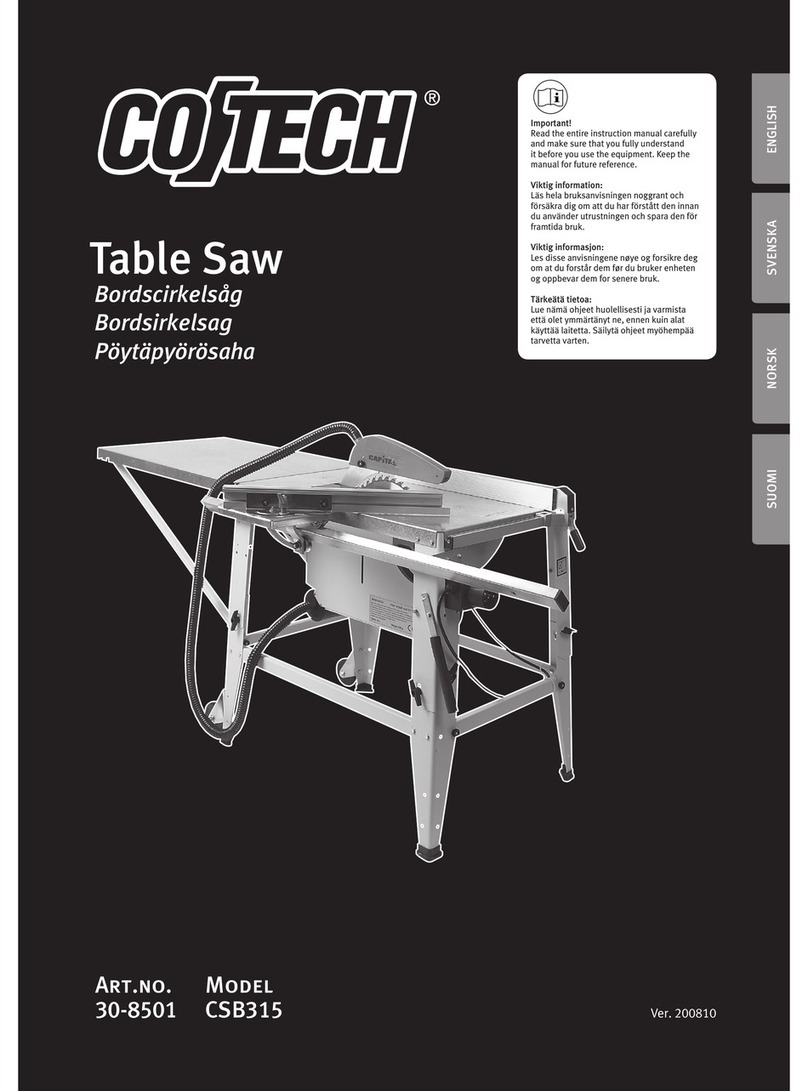
CO/Tech
CO/Tech CSB315 User manual
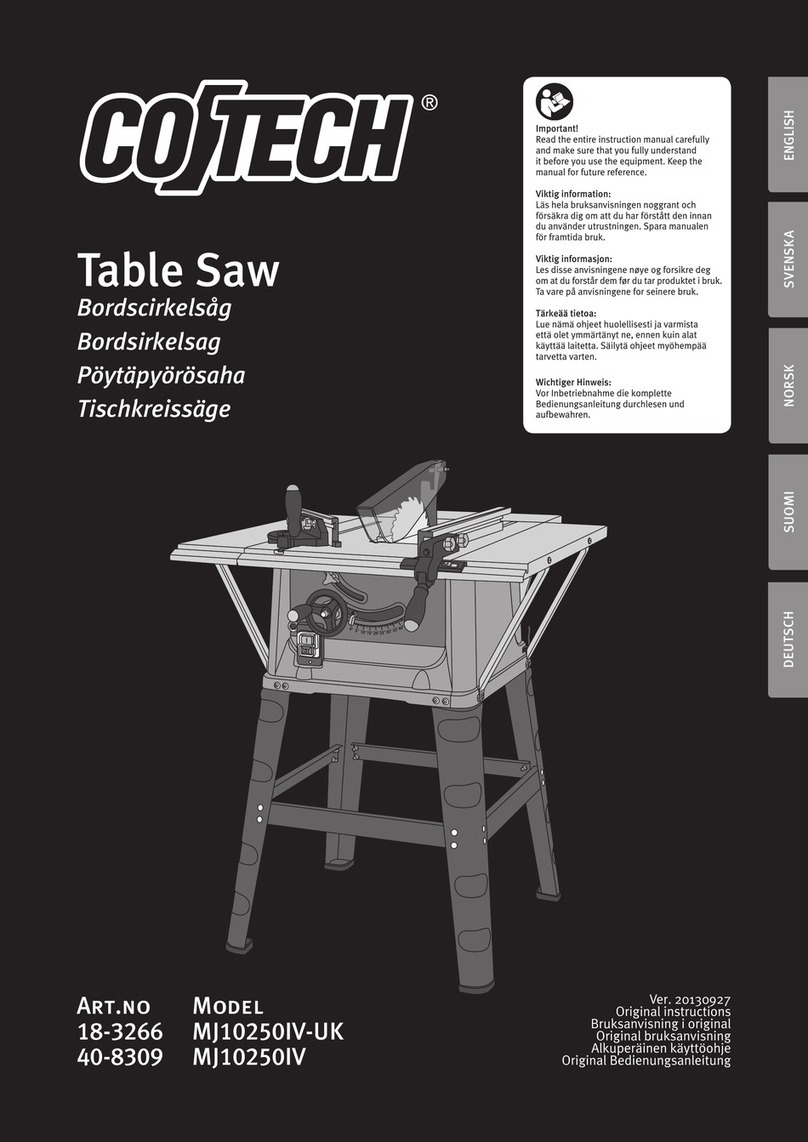
CO/Tech
CO/Tech MJ10250IV-UK User manual
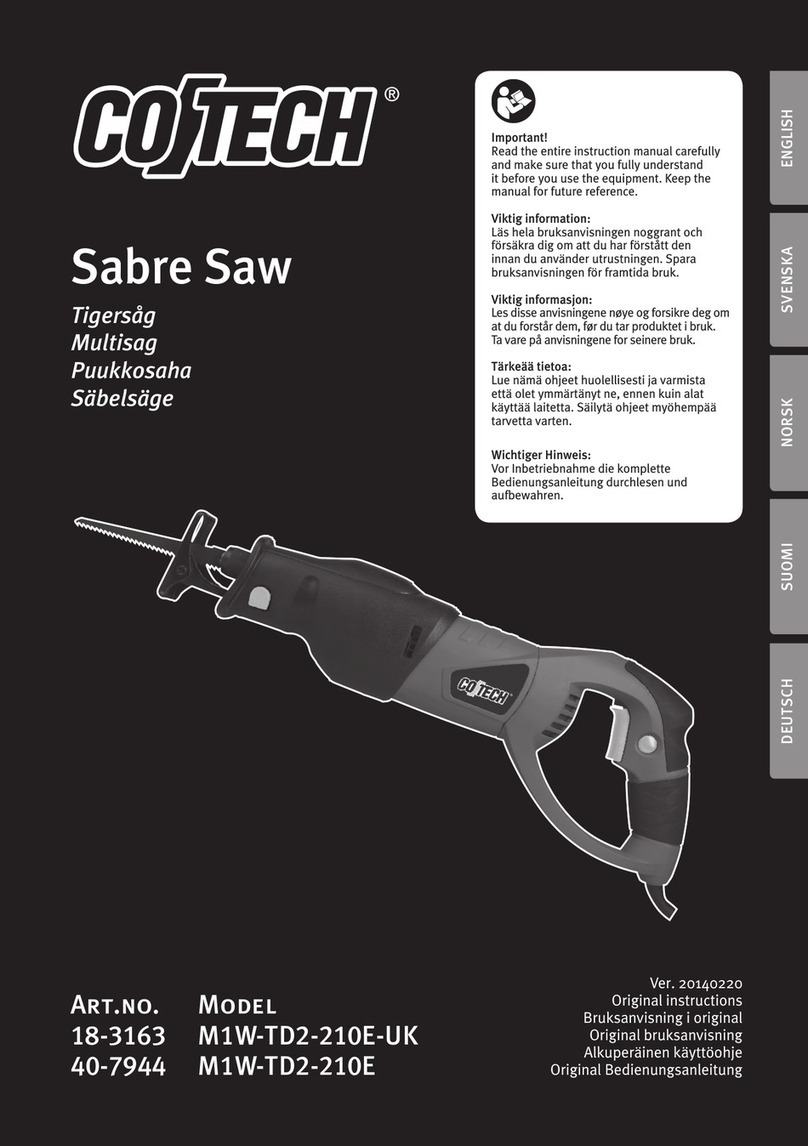
CO/Tech
CO/Tech M1W-TD2-210E-UK User manual
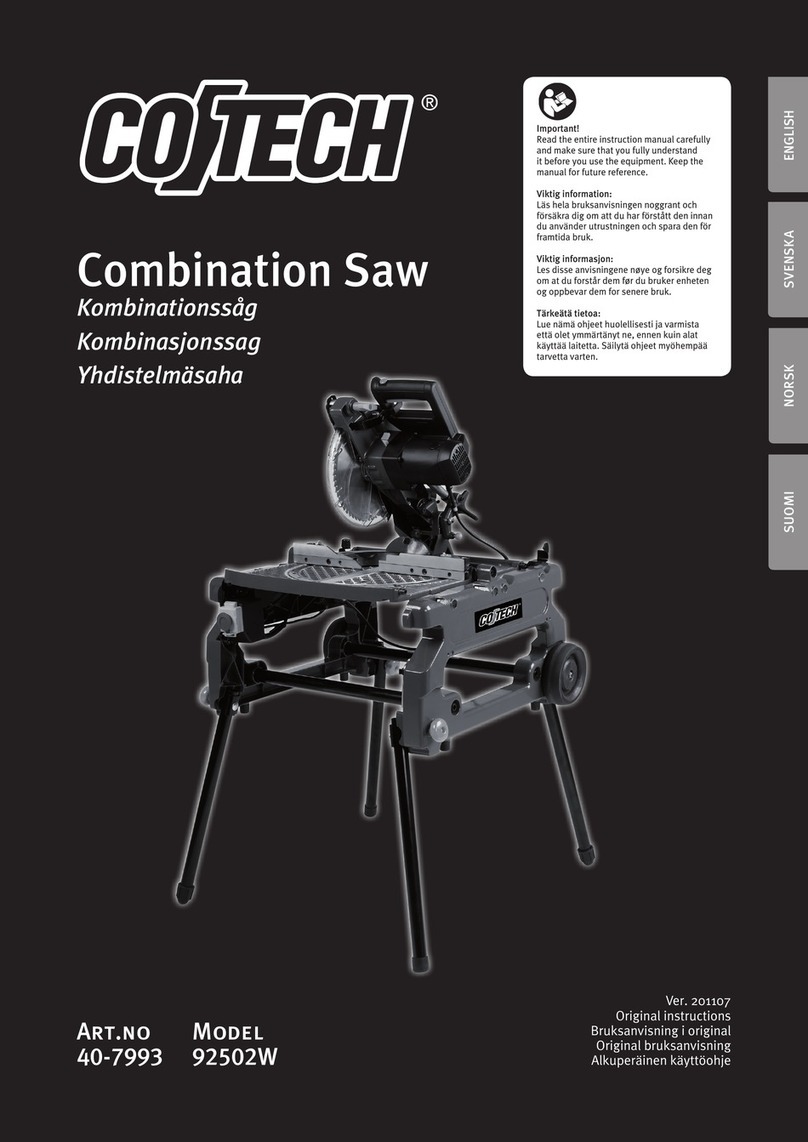
CO/Tech
CO/Tech 2502W User manual
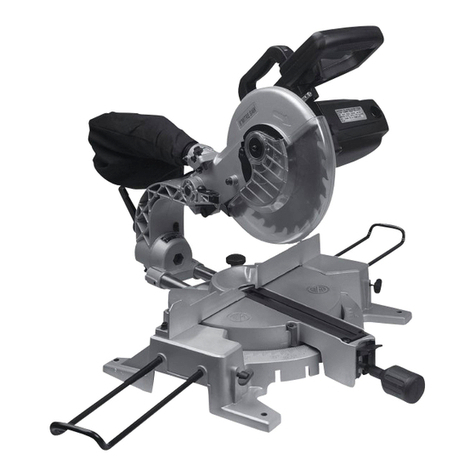
CO/Tech
CO/Tech J1x-JF2-210 User manual
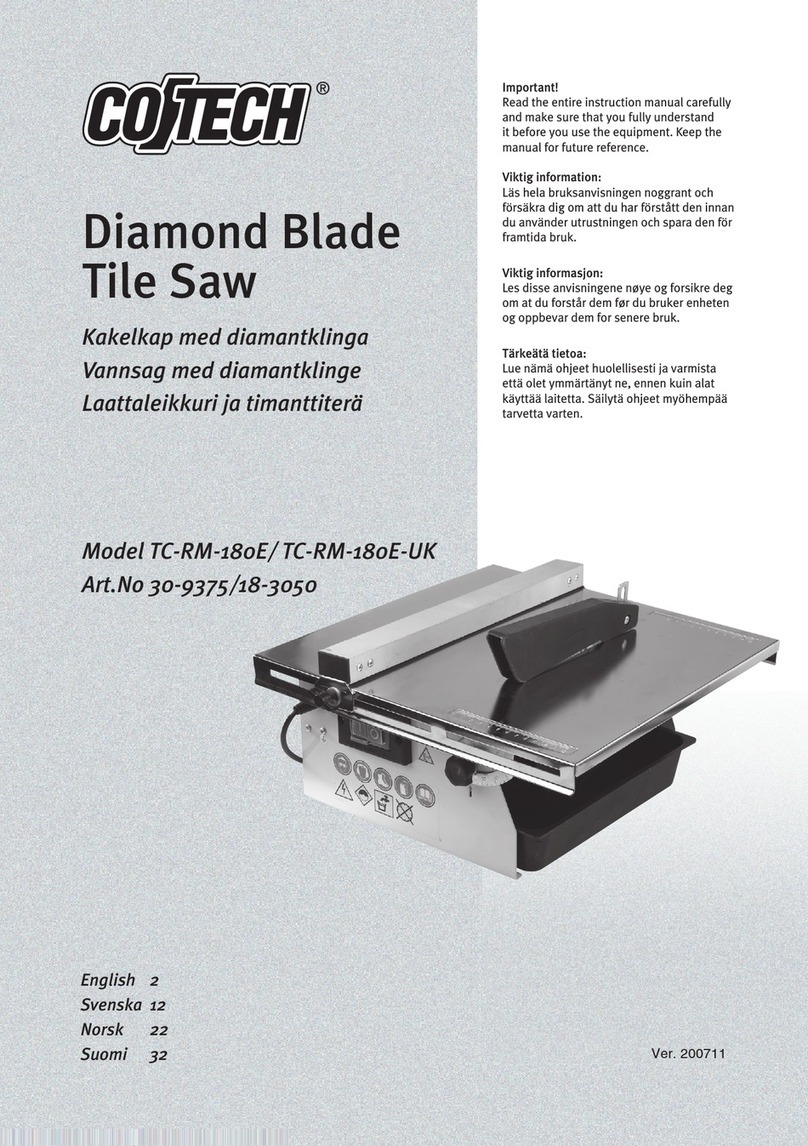
CO/Tech
CO/Tech TC-RM-180E User manual
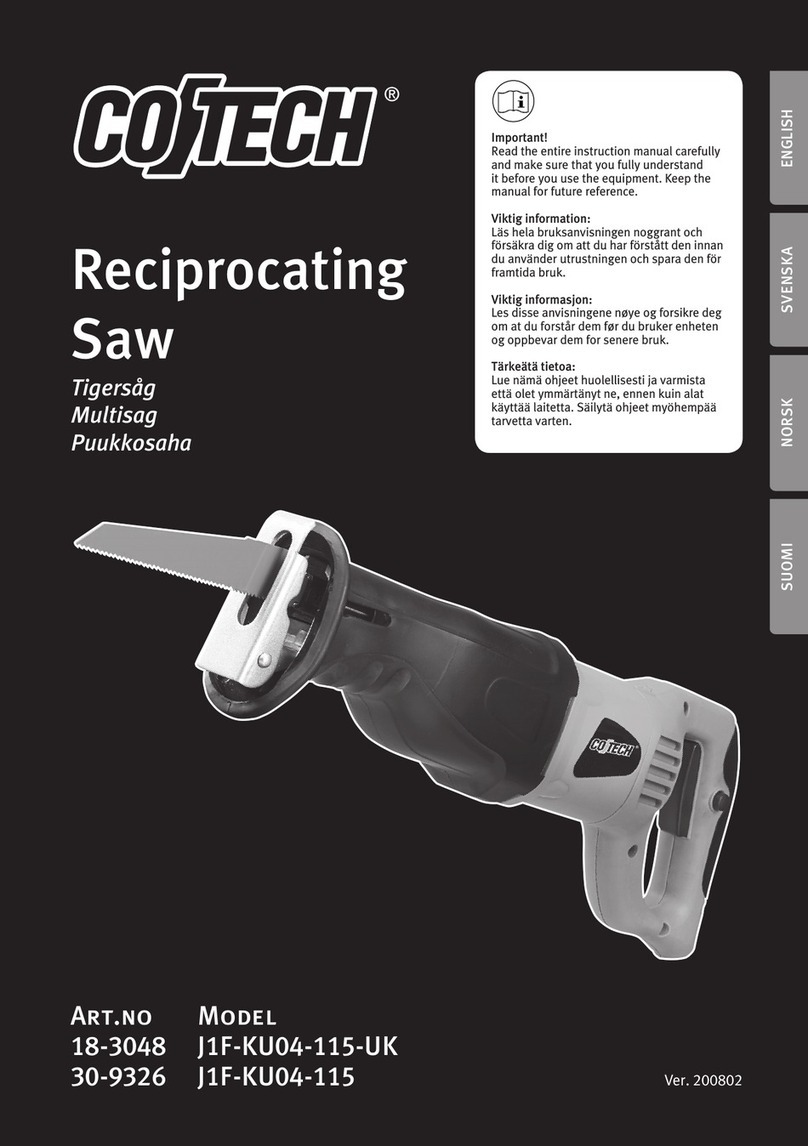
CO/Tech
CO/Tech J1F-KU04-115-UK User manual
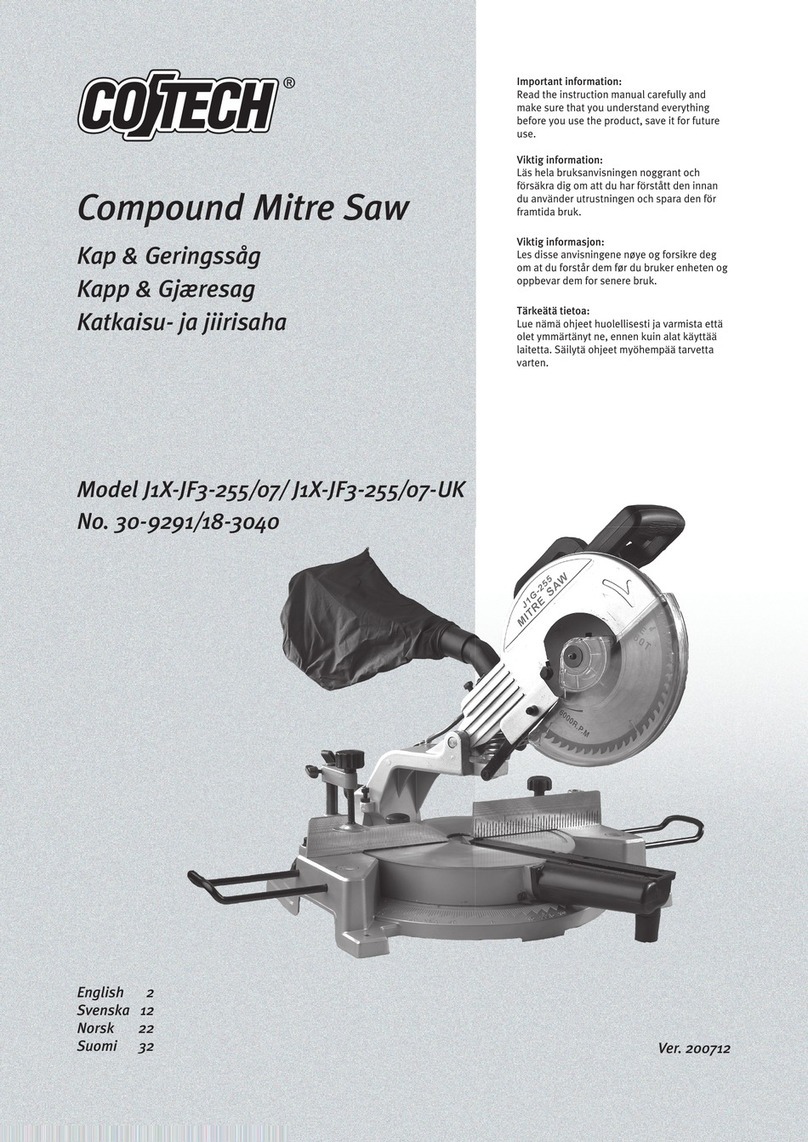
CO/Tech
CO/Tech J1X-JF3-255/07 User manual
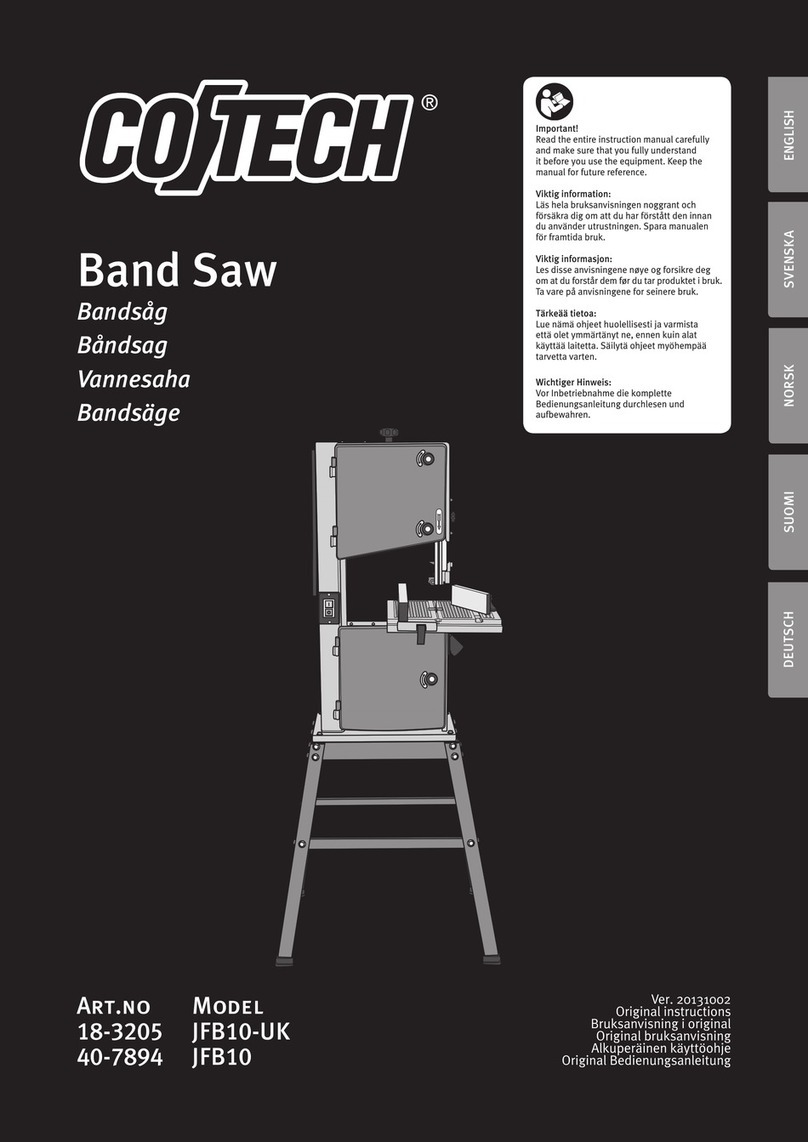
CO/Tech
CO/Tech JFB10-UK User manual
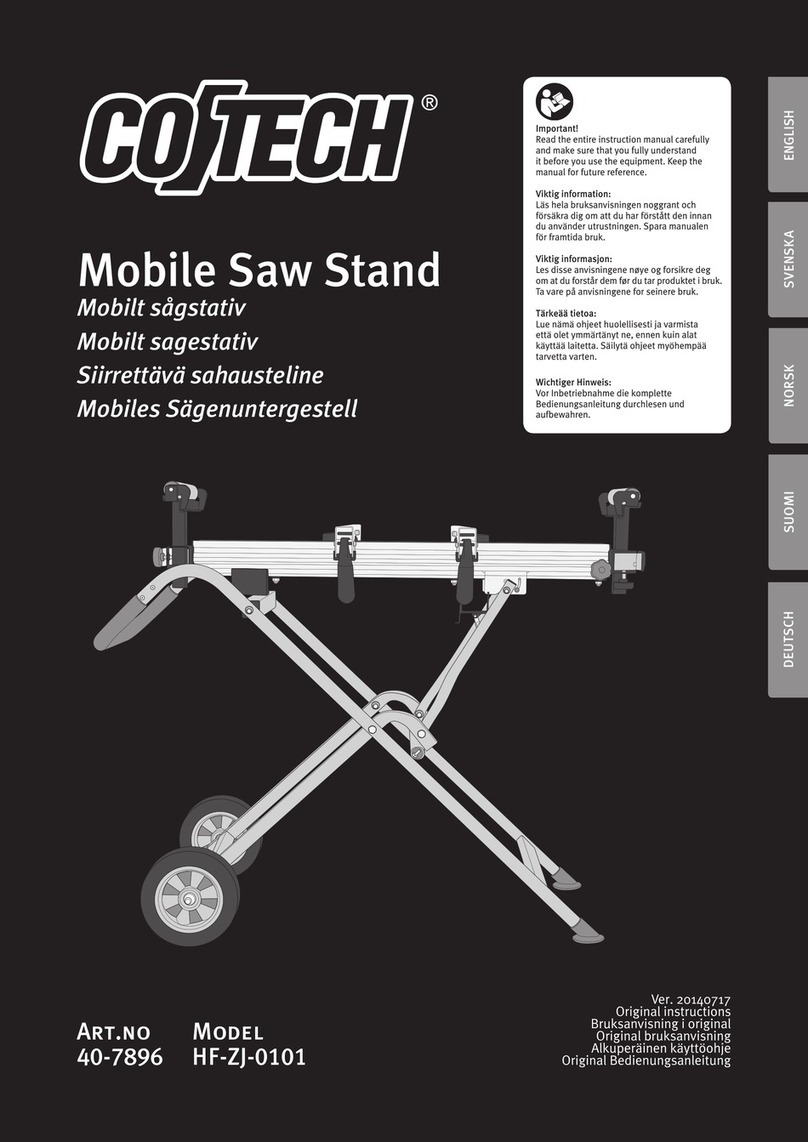
CO/Tech
CO/Tech HF-ZJ-0101 User manual
